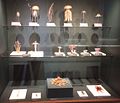 | other invertebrates. This makes the term "invertebrates" rather polyphyletic, so the term has little meaning in taxonomy. The word "invertebrate" comes... 41 KB (4,736 words) - 08:12, 11 April 2024 |
 | Wildlife of Antarctica (section Marine invertebrates) terrestrial invertebrates on the mainland, although the species that do live there have high population densities. High densities of invertebrates also live... 64 KB (6,710 words) - 10:19, 21 April 2024 |
This is a list of various species of marine invertebrates, animals without a backbone, that are commonly found in aquariums kept by hobby aquarists. Some... 52 KB (454 words) - 04:56, 1 April 2024 |
 | Seashell (redirect from Marine shell) plants and other phyla of invertebrates. The construction of functional keys for the identification of the shells of marine mollusks to the species level... 39 KB (4,747 words) - 23:18, 19 April 2024 |
 | Carboniferous (section Marine invertebrates) Carboniferous, and preferred higher drier ground. In the oceans the marine invertebrate groups are the Foraminifera, corals, Bryozoa, Ostracoda, brachiopods... 110 KB (11,562 words) - 12:52, 11 April 2024 |
 | Triassic (section Marine invertebrates) the conodonts disappeared, as did all the marine reptiles except ichthyosaurs and plesiosaurs. Invertebrates like brachiopods and molluscs (such as gastropods)... 68 KB (7,413 words) - 04:19, 25 March 2024 |
terrestrial invertebrates, marine invertebrates make up most of Earth's biodiversity which is why they do not go extinct as fast as other species. Marine Animals:... 10 KB (1,181 words) - 19:42, 15 January 2024 |
 | Chemical defense (section Marine invertebrates) a defensive mechanism is employed by many marine invertebrates. This mechanism relies on the invertebrates releasing and sensing chemical cues throughout... 56 KB (6,644 words) - 18:07, 30 January 2024 |
 | lobsters, with similar nauplius larvae. Barnacles are exclusively marine invertebrates; many species live in shallow and tidal waters. Some 2,100 species... 48 KB (4,636 words) - 06:48, 27 April 2024 |
 | Marine extinction intensity during Phanerozoic % Millions of years ago (H) K–Pg Tr–J P–Tr Cap Late D O–S The Triassic–Jurassic (Tr-J) extinction event... 141 KB (15,135 words) - 02:09, 23 April 2024 |
Paleocene (section Marine invertebrates) greatly impacted the evolution of fleas, ticks, and oestroids. Among marine invertebrates, plankton and those with a planktonic stage in their development... 153 KB (17,284 words) - 04:32, 22 April 2024 |
Pelagic zone (section Pelagic invertebrates) amphipods, rotifers and cladocerans. Thorson's rule states that benthic marine invertebrates at low latitudes tend to produce large numbers of eggs developing... 14 KB (1,445 words) - 07:29, 8 April 2024 |
 | Late Devonian extinction (section Marine invertebrates) specialist taxa occupying small niches were harder hit than generalists. Marine invertebrates that lived in warmer ecoregions were devastated more compared to... 76 KB (8,630 words) - 00:36, 30 April 2024 |
TOAE had minor effects on marine reptiles, in stark contrast to the major impact it had on many clades of marine invertebrates. In fact, in the Southwest... 111 KB (11,601 words) - 01:25, 30 April 2024 |
 | Glass sea creatures (redirect from Glass marine invertebrates) the Blaschka sea creatures, glass marine invertebrates, Blaschka invertebrate models, and Blaschka glass invertebrates) are works of glass artists Leopold... 35 KB (4,128 words) - 23:12, 10 January 2024 |
Marine larval ecology is the study of the factors influencing dispersing larvae, which many marine invertebrates and fishes have. Marine animals with a... 40 KB (5,314 words) - 18:23, 13 March 2024 |
 | Drug discovery (section Marine invertebrates) [citation needed] Marine environments are potential sources for new bioactive agents. Arabinose nucleosides discovered from marine invertebrates in 1950s, demonstrated... 58 KB (6,730 words) - 19:32, 16 January 2024 |
 | Aquatic animal (redirect from Semi-aquatic invertebrate) locomotion Aquatic mammal Aquatic plant Freshwater snail Marine biology Marine invertebrates Marine mammal Terrestrial animal Terrestrial ecosystem Terrestrial... 9 KB (871 words) - 05:55, 5 February 2024 |
a group of eukaryotes that are parasites of animals, especially marine invertebrates. The two groups, the haplosporids and paramyxids, are not particularly... 7 KB (595 words) - 20:02, 22 April 2024 |










